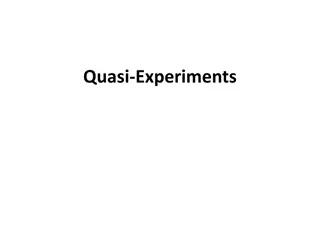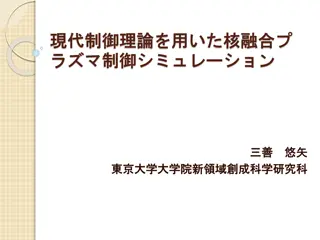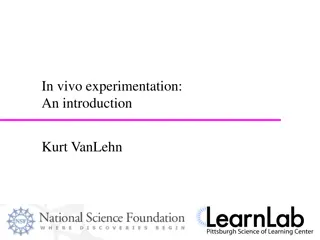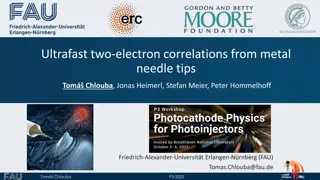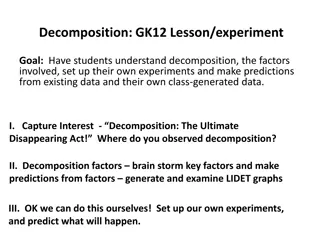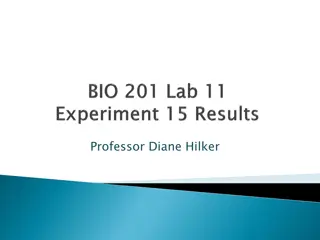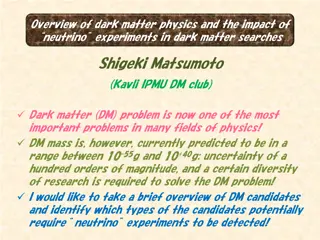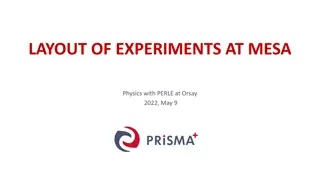Designing Experiments
The assumptions of ANOVA and 1-factor GLM, focusing on random sampling and independence. Learn about assigning samples to treatments through random and grouped approaches, and the importance of randomness in experimental design. Discover how to spot pseudo-replication in ANOVA and the significance of sample selection in ensuring generalizability.
Download Presentation

Please find below an Image/Link to download the presentation.
The content on the website is provided AS IS for your information and personal use only. It may not be sold, licensed, or shared on other websites without obtaining consent from the author.If you encounter any issues during the download, it is possible that the publisher has removed the file from their server.
You are allowed to download the files provided on this website for personal or commercial use, subject to the condition that they are used lawfully. All files are the property of their respective owners.
The content on the website is provided AS IS for your information and personal use only. It may not be sold, licensed, or shared on other websites without obtaining consent from the author.
E N D
Presentation Transcript
Designing Experiments 1-Factor, 2 or more treatments 1
Assumptions of ANOVA / 1-factor GLM 1. Random sampling (allocation to treatments) 2. Independence 2
Assumptions of ANOVA / 1-factor GLM 1. Random sampling (allocation to treatments) 3
Assign samples to treatments: Approach 1 Randomly assign samples to treatments Treatment 1 Treatment 2 Treatment 3 4 Harvest mouse by Harlequeen CC BY 2.0
Assign samples to treatments: Approach 1 Randomly assign samples to treatments Treatment 1 Treatment 2 Treatment 3 Why is random important? THINK 5
Assign samples to treatments: Approach 2 Group samples by character Randomly assign samples within group to treatments Treatment 2 Treatment 1 Treatment 3 6
Assign samples to treatments: Approach 2 Group samples by character Randomly assign samples within group to treatments 7 http://365caws.blogspot.com/2016/07/anticlea-occidentalis-mountainbells.html
Select samples Randomly sample population of interest. (Helps ensure generality, but not an assumption of the test.) 8
Assumptions of ANOVA / 1-factor GLM 2. Independence 9
Spotting pseudo-replication in ANOVA Typical NOT pseudo-replication A B C D E F G A B C D E F Treatment 1 Treatment 2 H I J K L M N A B C D E F Treatment 3 O P Q R S T A B C D E F Non-independent measurements share a letter 10
Spotting pseudo-replication in ANOVA Pseudo-replication NOT pseudo-replication A A B B C C A B C D E F Treatment 1 Treatment 2 D D E E F F A B C D E F Treatment 3 G G H H I I A B C D E F Non-independent measurements share a letter 11
Sample size 12
Minimal requirement 2 or more independent samples per treatment Treatment 1 How many samples? Treatment 2 Use power analysis Treatment 3 13
Sample size Use power analysis 14
How many treatments? Depends on what you want to test Which, of the two experimental designs, below, will have greater power? THINK. Treatment 1 Treatment 2 Treatment 3 vs. Treatment 1 Treatment 2 Treatment 3 Treatment 4 16
How many treatments? Depends on what you want to test For a given amount of resources, power decreases with treatment number. Treatment 1 Treatment 2 Treatment 3 vs. Treatment 1 Treatment 2 Treatment 3 Treatment 4 17
Basic experimental design 1. Random sampling (allocation to treatments) 2. Independence 1. Sample size 1. Number of treatments 18




